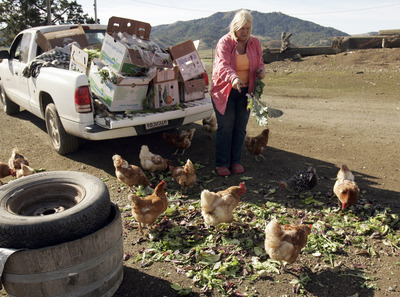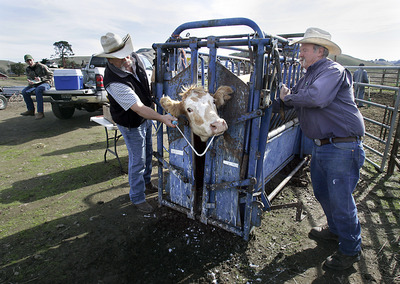Land trust has kept Marin's farms in business for 30 years
Rob Rogers, Marin IJ link to article
November 22, 2010
Kitty Dolcini feeds some of her open range chickens at her Red Hill Ranch on

When Rick LaFranchi looks out over his family's 1,150-acre Nicasio ranch, he sees the same fields, many of the same buildings and the descendants of the same dairy cows his grandfather brought to West Marin more than a century ago.
But LaFranchi also sees what might have been, and almost was: a West Marin landscape divided into suburban house lots, one in which farmhouses and dairies had been replaced by starter castles and gated developments.
"I have no doubt the majority of West Marin would have been, at best, broken up into 60-acre 'ranchettes,'" said LaFranchi, whose family owns and operates the Nicasio Valley Cheese Co. "There would have been a lot of big estates with no agricultural activity whatsoever on them."

That vision of the county's future -- one that seemed likely three decades ago -- was what convinced rancher Ellen Straus and wildlife biologist Phyllis Faber to create the Marin Agricultural Land Trust in 1980. The trust will celebrate its 30th anniversary with a Dec. 10 dinner at The Dance Palace in Point Reyes Station.
"All of the farms in East Marin had gone out of business, and the same process was well on its way in West Marin," said Faber, who lives in Mill Valley. "Tomales Bay was just littered with 'For Sale' signs. Farms were failing right and left. But both Ellen and I were really hopeful that agriculture should have a chance."
The nonprofit organization has been credited with preserving Marin County's rural character and saving countless family farms from extinction through a concept that seemed radical in 1980: buying the development rights from local farms in order to preserve the land for agriculture. More than a third of the county's private agricultural land -- including 63 farms on 41,600 acres -- have been permanently preserved by MALT.
"To sustain agriculture, you have to keep it viable," said former Marin County supervisor Gary Giacomini, who worked with Straus and Faber to create MALT and pushed for zoning changes to prevent the subdivision of family farms. "MALT operates by buying up development rights, giving the landowner the resources to have a viable operation. The effect of it has been to preserve agriculture in this county in perpetuity. It's my favorite thing that I had a hand in creating."
While conservation easements -- agreements that reduce taxes on land where the owner agrees to restrict development -- were common in 1980 as a means to preserve open space, easements to protect farmland were all but unknown, and creating them posed challenges. Unlike the owners of conservation land, farmers and ranchers needed a means to make a profit from their property.
"Giving away part of their rights for a tax benefit might appeal to a few very wealthy landowners. But the average dairy farmer in West Marin was not going to do it," said Ralph Grossi, a Novato dairy farmer and one of MALT's founding members. "An early turning point was the idea of purchasing development rights. Once we started down that path, more people became believers -- though they didn't think we'd be able to raise the money to do it."
Grossi needn't have worried. The trust's total assets now comprise $11.7 million, and MALT has an annual budget of $5.5 million. The majority of those donations -- 51 percent -- comes from individual contributions, grants and bequests; about 34 percent flows from government grants and another 12 percent comes from the trust's investments. At least 3,687 people gave money to MALT last year, with 41 percent of those donors contributing for 10 years or more.
Those donations allow MALT to purchase agricultural easements -- and those easements have allowed farmers and ranchers to invest in businesses on their farms, such as the Straus family's organic creamery and the Point Reyes Farmstead Cheese Co. at the Giacomini Dairy. They have also allowed farmers to deal with the thorny problem of how to pass a farm from one generation to the next.
"Most families here are large -- usually five or six kids -- but usually only one or maybe two of them wants to stay on the ranch," said LaFranchi, who serves as vice president of the MALT board. "MALT enabled them to buy out their siblings and continue on with the agricultural tradition. Without it, they'd have been forced to sell (the property)."
In addition, MALT's initial partnership between rancher Straus and biologist Faber helped establish the agenda for the organization. Farms would be preserved not only for the benefit of the farmers, but for everyone and everything that lived in Marin County.
"The first time I stood up at a meeting and said that farmers produce more than food and fiber -- that they are responsible for improving water quality, wildlife habitat and open space -- people looked at me funny," Grossi said. "But the people who benefited from MALT weren't just the landowners who were able to stay, and pass on their land to the next generation. The open space, the water protection, all the things that make West Marin beautiful -- those values accrue to the community at large."
To that end, MALT staff regularly inspect properties to ensure owners are complying with the terms of their easement, and take part in conservation projects, such as removing weeds and restoring streams.
"The owners of these properties have been stewards of the land for multiple generations over 150 years," said Robert Berner, MALT's executive director. "As the holder of these conservation easements, we're responsible for making sure the terms of the easements are observed and respected. Protecting and enhancing the natural resources on these properties has been a significant part of our activity."
The trust also organizes hikes, farm tours and other activities on MALT properties to educate visitors and help residents see farming as part of Marin County's identity.
"You can't get people to preserve things they don't care about," said Deborah White, director of communications and membership for MALT. "We bring about 1,000 people out to farms and ranches every year, and our Farm Field Studies program brings out students and teachers. It helps people make the connection that milk doesn't come from a carton or the fridge."
Berner doesn't know whether other agricultural land trusts, like Solano and Yolo counties' land trusts, were directly inspired by MALT. But other observers say the trust's influence -- and its success -- has been felt far and wide. MALT earned accreditation as a member of the national Land Trust Alliance earlier this year.
"MALT's not for everyone. But it's certainly a viable tool for a lot of families," said David Lewis, executive director of the University of California Cooperative Extension in Novato. "It's enabled a lot of them to stay on the farm and explore options for growing and providing agricultural products. Without it, our physical view of the landscape wouldn't be there, and people would have a much more difficult time being a part of it."
Contact Rob Rogers via e-mail at rrogers@marinij.com
How MALT works
The Marin Agricultural Land Trust purchases the rights to any non-agricultural development of a farm property.
"Under typical zoning laws, a 600-acre property could legally be split 10 ways, and a residential homestead built on each parcel," said Jeff Stump, easement program director for MALT. "We retire those rights."
An independent appraiser establishes the value of each property with and without those development rights, and MALT agrees to pay the farmer or rancher the difference.
"Those easements have capitalized diversification projects like the Straus creamery, and allowed family members who wanted to continue in agriculture to compensate their siblings," said Ellie Rilla, community development adviser for the University of California Cooperative Extension in Novato.
IF YOU GO
The Marin Agricultural Land Trust will celebrate its 30th anniversary during its annual holiday event at 5 p.m. Dec. 10 at The Dance Palace, 503 B St. in Point Reyes Station. The free event will include food and a 10-minute film about the trust's history.



